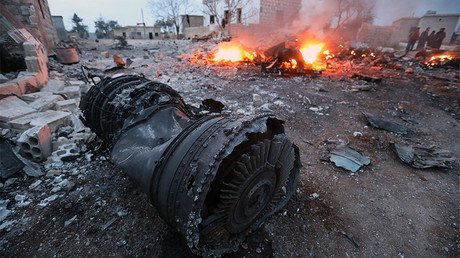No anti-aircraft weapons sent to 'our' Syrian rebels – Pentagon after downing of Russian jet

The US military has said no anti-aircraft weapons have been shipped to the militias it backs in Syria amid speculation the Russian Su-25 jet downed in Idlib, north-west Syria may have been shot down by a US-made missile.
“The United States have not provided any of its allied forces in Syria with anti-aircraft weapons,” Pentagon spokesman Maj. Adrian J.T. Rankine-Galloway told TASS. He said the US-led coalition is currently not engaged in any operations in the area where the jet was downed Saturday. He added that the coalition's combat efforts are “geographically orientated on the current fight with Islamic State (IS, formerly ISIS, ISIL) in eastern Syria.”
The Russian Defense Ministry said earlier the jet was attacked from the ground by rebels possibly using a man-portable air-defense system (MANPADS) in the designated ceasefire zone in Idlib province. The Pentagon will study “the veracity of the statements” put forward by the Russian military to ensure security of its coalition allies, Rankine-Galloway added.
Some Russian legislators and experts interviewed by local media voiced concerns that the weapons may have its origins in the West and then smuggled through a neighboring country into Syria. The deputies urged a thorough investigation to trace the air defense system's point of origin.
The pilot, identified in some reports as Major Roman Filipov, ejected from the stricken aircraft and parachuted to the ground. It's believed the officer was engaged in a firefight with militants before being killed. Purported images of his personal belongings, including his gun and a recommendation for a state honor, have surfaced on social media. As did footage of militants shouting “Allahu Akbar” (“God is great”) at the sight of the jet crashing and militants taking selfies with the body of the slain pilot.
The Russian ministry, in cooperation with Turkey, is now trying to retrieve his body. The Tahrir al-Sham extremist group, which has links to the Al-Nusra terrorist group, claimed responsibility for the attack. However, posts and videos of the downed Russian plane appeared on the social media accounts of the Jaysh al-Nasr militant group which is affiliated with the Free Syrian Army.
The US has repeatedly denied it had shipped portable air defense missile systems to the rebels, brushing off Moscow’s concerns in the process. The 2017 National Defense Authorization Act enabled the Pentagon to authorize shipments of anti-aircraft weapons to Syrian rebels for it to be used “against aircraft of one side only.”
The Russian Defense Ministry argued that if such weapons were brought into Syria, they could easily fall in the hands of IS and other terrorists.
The Pentagon then denied it had any plans to send the weapons.
The 2018 defense act outlines significant directives pertaining to MANPADS deployment in Syria. Section 1227 of the bill states that in order to provide air-defense systems to the “vetted Syrian opposition,” the Secretary of Defense and the Secretary of State must first inform the congressional committee; describe in detail the location of the group; its intelligence assessment; the number of devices to be shipped; as well as an “explanation of the purpose and expected employment” of the defense systems.

















